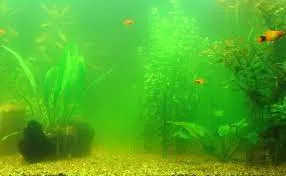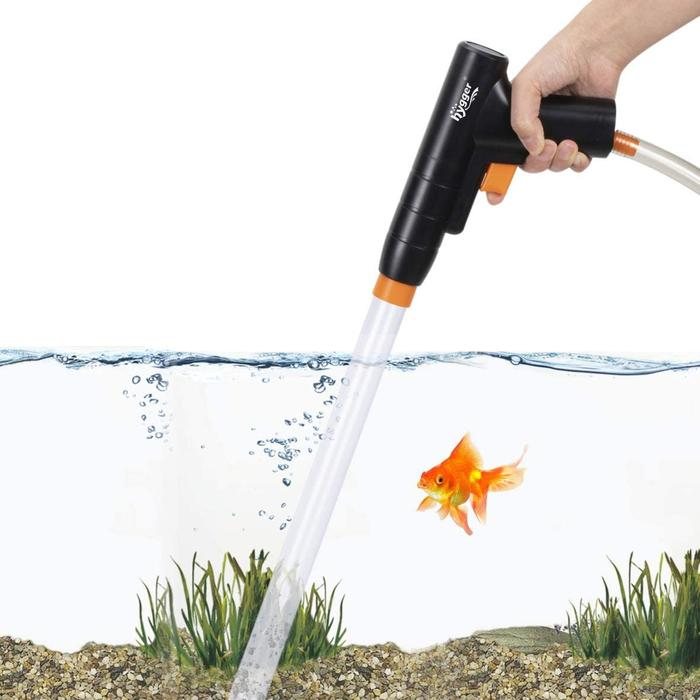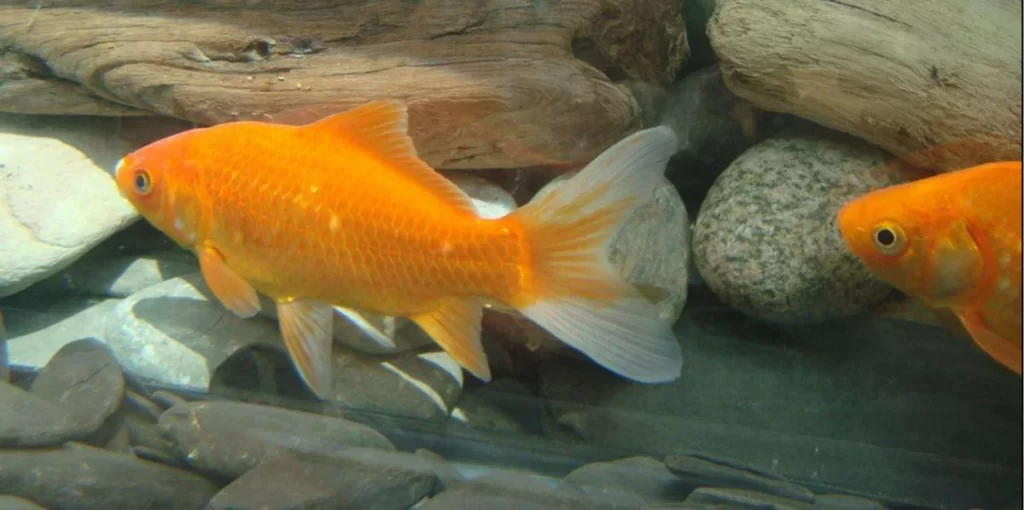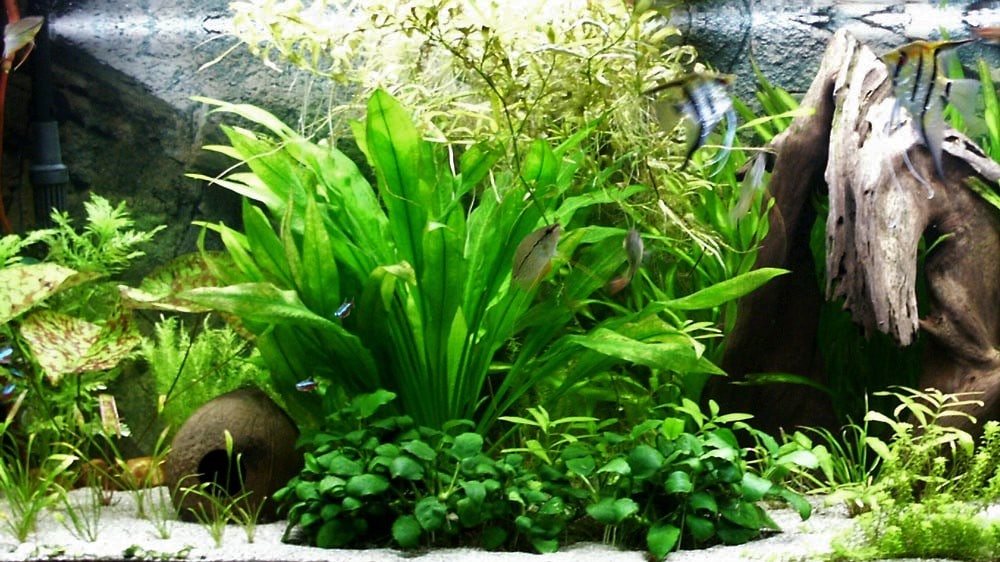Gravel harbor food leftovers, decaying plants, and fish excrement caught between stones which progressively render the water hazardous, sometimes even causing a terrible stink. The use of a siphon to clean aquarium sand is something that needs some skill. Although it is an essential instrument, there are several techniques to be careful of when working with sand.
Siphons, sometimes known as gravel vacuums, are devices that produce a gentle vacuum in a tank by allowing water to flow through them. The goal is to raise the sand layer just enough to let the dirt and dust fall to the bottom. This is then eliminated from the system together with the water that is expelled from the siphon.
This procedure eliminates part of your tank’s water, so it is an intelligent choice for integrating it with your regular tank maintenance schedule. You may keep pulling out water until you’ve achieved the quantity you desire, and so you can refill the container with new water to start again.
Using a gravel vacuum is a simple and effective way to clean sand and gravel in the aquarium. Vacuuming gravel and other trash up the broad pipe with the aid of a flexible tube and larger diameter pipe is accomplished by gravel vacuums that use a mix of the two. Substrate rises to the top of the box and is collected in a bucket while dirt floats to the surface.
In terms of vacuuming, sand and gravel are pretty different. Sand can be pulled up and destroyed by the gravel vacuum, although with experience, the void can just be hovering marginally more significant above the sand, and this will be raised, cleaned, and dumped back down.
To clean aquarium gravel, fill half of a bucket with water from the fish tank. To complete the bucket, add a few gallons of clean tap water. To avoid harming the fish, you must combine old and fresh water before adding it to the aquarium. Though frequent water changes will discharge the hazardous waste, unclean gravel will rapidly contaminate the freshwater.
Therefore, it’s vital to clean aquarium gravel periodically, coupled with your outer surface and decorating. The objective is to vacuum as often as you can when completing your usual weekly or fortnightly water changes and use a vacuum siphon kit.
How to Clean Aquarium Sand
Aquariums are fantastic if they’re clean; however, they require periodic upkeep to maintain them that way. To clean aquarium sand, which becomes contaminated with various wastes, is vital for maintaining a pleasant fish tank and keeping your fish alive. Because sand is so fine, many mistakenly believe that cleaning it is more complicated than cleaning aquarium gravel.
It’s sometimes even more accessible. Cleaning aquarium sand is quite identical to cleaning aquarium gravel. Put the gravel vacuum over the tank’s bottom and slowly move it about until you reach a height where waste is pulled inside, and sand is left behind, then remove the vacuum from the tank. Vacuuming the sand too profoundly will result in more trash being collected on the surface.
Keep an eye on the surface when it’s hovered over. When cleaning the sand, flip the sand over after the first pass and go over it again. When you do it, the sand in your aquarium will seem like it’s just been replaced. It would be best if you used this technique to clean sand and gravel in aquariums.
Cleaning Aquarium Sand
Cleaning aquarium sand before use is strongly advised. No matter how often the packaging claims that the item has been pre-washed, it may still contain dirt, resulting in cloudy water. The sole exception to this rule is Living sand, which includes water and live microbes and thus does not need rinsing before being added to your aquarium.
Cleaning aquarium sand doesn’t end when you add the substrate. The substrate will collect debris, mostly fish excrement, and residual food, over time. Routine cleaning using a gravel vacuum or siphon is suggested to maintain the aquarium substrate neat.
How to Clean Aquarium Gravel
Fish keepers must use caution after receiving their training on how to clean sand and gravel in aquariums. Removing gravel, sand, and debris is a critical initial step in maintaining excellent water quality for aquarium fish. Even if it’s promoted as “pre-rinsed” or “pre-cleaned,” new aquarium gravel might still include dust, dirt, grit, and even dangerous residue from the facility where it was packed.
To clean aquarium gravel, fill half of a bucket with water from the fish tank. To complete the bucket, add a few gallons of clean tap water. To avoid harming the fish, you must combine old and fresh water before adding it to the aquarium. The fish should be placed in the bucket now. Disconnect all of the aquarium’s electrical components. Empty the tank. Using a yard hose, fill a bucket with water and put the stopper on full blast.
The water should be flowing clean in the bucket after vigorously stirring and rinsing the pebbles. Repeat the whole procedure with the second bucket. Warm tap water may be used to wash the tank. Soap should not be used. The filter, thermostat, and tubes should be cleaned. Paper towels may be used to clean the interior of the device.
Products recommended are Luigi’s Aquarium/Fish Tank Siphon and Gravel Cleaner, Natural Rapport Aquarium Gravel Cleaner, and hygger Aquarium Gravel Cleaner.
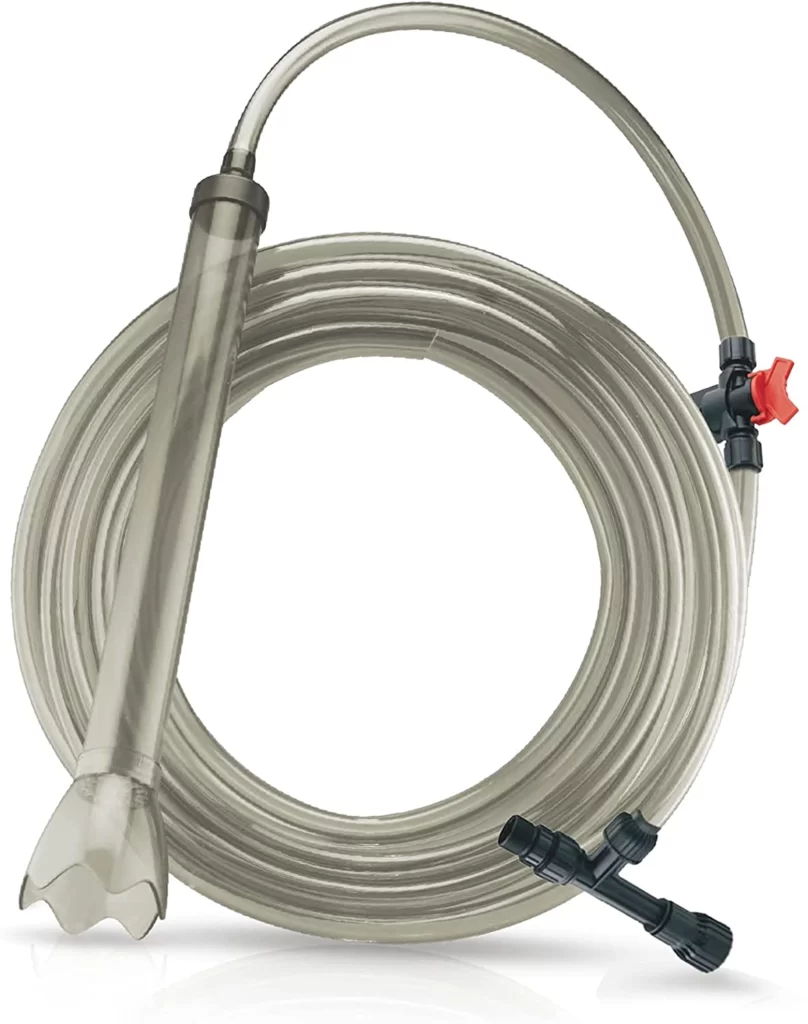
How to Clean Aquarium Gravel Algae
Regardless of what you are doing, if you combine fish, water, and sunlight, you will always have algae. As a general rule, fish will not be harmed by small amounts of algae in their aquariums. A gravel vacuum should be used regularly in all aquariums to remove trash and sediment from the substrate.
To get rid of the algae, you may use a gravel vacuum to flip the gravel substrate over, preventing it from receiving any light. To clean sand and gravel in aquariums, you also need to clean aquarium gravel algae.
Following methods are used to clean aquarium gravel algae. The most effective way to eradicate algae from aqua gravel is to eliminate its food supply: light, phosphate, and nitrate. This is accomplished mainly via routine maintenance performed using a gravel siphon. Vacuuming will flip over the substrate, preventing it from receiving light, and will also remove ammonia and phosphorus from the water.
Each fish species has a unique tolerance for elevated nitrate levels. Certain fish can handle very high amounts, whereas others cannot. Conduct a study before taking your fish home to determine the required water chemistry conditions. Conduct frequent water chemistry tests to ensure that all of your levels, including nitrate, are below safe limits.
Phosphate might be more challenging to eliminate. They are often seen in significant concentrations in freshwater aquariums. They may be added to different salt mixes in saltwater aquariums since certain coral species need phosphate. If your tank has no corals, you do not need to employ a coral-specific combination.
Although phosphate-binding materials may be added, persistent difficulties with water supply levels may necessitate using an alternative source, like bottled (rather than distilled) water. Products recommended are API ALGAEFIX Algae Control 8-Ounce Bottle and AquaticHI 5 in 1 Multi-Function Aquarium/Fish Tank Cleaning Tool, Algae Scraper.
Aquarium Sand Vacuum
If you had asked someone a few years ago, they would have said what the best aquarium sand vacuum is; they would have most likely said “gravel.” Times have changed, and a new and familiar element — sand — now comes into focus. Sand is a friendly and flexible buddy that instantly transforms the aquarium into the focal point of your space due to its wide range of colors, textures, and sizes.
Nowadays, many vacuums include a gravity-dependent siphon mechanism. The fast vac pro, on the other hand, contains a battery-operated vacuum. It provides a much better vacuum and thorough cleaning. This is a perfect pump for folks who are meticulous about their gravel being spotlessly clean.
It makes it simple to clean sand and gravel in aquariums and replace the water regularly. Even weekly! Because it is fast and straightforward to use, you may easily clean the whole tank regularly. It requires four AA batteries and boasts a continuous run duration of around four hours. Due to the lack of a hose functions more like a true vacuum than like a siphon.
Best Aquarium Vacuum for Sand
If sand or gravel is more appealing to your site, then go ahead and use that in your tank. Among vacuums, the best aquarium vacuum for sand is the TERA PUMP vacuum. A significant benefit of this vacuum is its versatility since it may be used with gravel or sand. It needs to if you have over one fish tank at your disposal.
The pipes of this gadget are made of PVC, which is a durable and long-lasting material. In addition, it’s BPA-free and easy to use. As a result, your fish would be overjoyed that you obtained it. The TERA PUMP has two different nozzles to choose from. Instead of draining water, the shorter of the two nozzles is used to remove food waste and other junk from the tank.
The TERA PUMP features an incorporated unique filter that prevents sand from penetrating and obstructing the pump while working at a significant concentration of 1.5 liters of water per minute. It has a colossal suction tube, so it’s perfect for tanks up to 10 gallons. The pump’s technology is proprietary and very efficient.
Cleaning and emptying garbage bins are also made simple, thanks to the simple design of this product. Additional benefits include the fact that the TERA PUMP Tank Cleaner is very light and portable. As a result, you’ll be able to shift it across tanks rapidly.
Products recommended are TERA PUMP Genuine Aquarium Pond Fish Tank Cleaner, Laifoo Aquarium Siphon Vacuum Cleaner for Fish Tank Cleaning Gravel, and Sand.
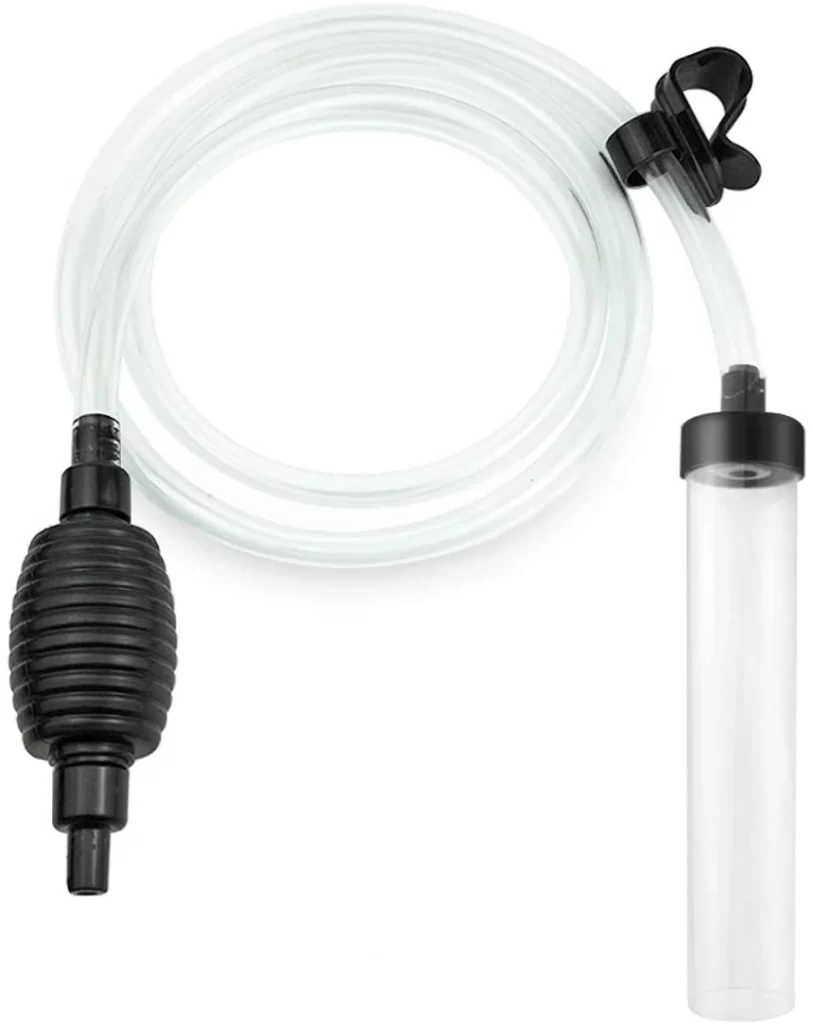
How to Clean Saltwater Aquarium Sand
Physically clean to highlight the charm of the aquarium. A dingy sandbed may significantly diminish your aquarium’s impressiveness. Biologically pure to eliminate any ammonia, nitrate, or phosphate concerns. To clean saltwater aquarium sand, use the following methods.
If the aquarium is less than six months old, you see algae blooming all over; please do not be frightened; this is a standard component of the ecosystem establishing balance. Additionally, the kind of sand and substrate used in your aquarium might affect how clean it seems.
More significant particle substrates, such as CaribSea’s Crushed Coral, have grains of a diameter of 2.0-5.0mm, which creates larger spaces for leftover food and debris to settle in. Additionally, more extensive particle sands may be too big for some animals. We will discuss moving through it successfully and clean.
Smaller particle sands, such as CaribSea’s Fiji Pink and High-Grade Reef sand, with grains ranging in diameter from 0.5 to 2.0mm, allow debris to float on the surface rather than being stuck. Additionally, the most petite particle sizes make it simpler for creatures to clean.
Best Way to Clean Sand in Aquarium
The best way to clean sand in the aquarium is to bring a big saucepan of water to a boil. Put the boiling hot water over the sand and constantly swirl until all of the sand is completely immersed in boiling water. Pour the sand into a big bucket and thoroughly clean it under running water before using it again. Once the water from buckets is flowing clear, it is safe to assume that sand is washed as well.
How to Clean Aquarium Sand before Use
To clean aquarium sand before use, you should use hot water to clean the aquarium sand. Adding non-iodized salt to the water used to clean the tank is an option if desired. Scrape off every alga, sand particles, and calcium clusters from the glass that you can’t remove with water simply using a clean razor blade.
How Do You Clean Sand in a Fish Tank
“Should I clean aquarium sand, is a common query among fish owners who are new to using sand substrates.” Moreover, the short and simple answer is yes. You should thoroughly clean the sand in a fish tank. If you do not, you may have significant water clarity concerns, which may cause your filter to get clogged.
Electric Aquarium Sand Cleaner
Electric aquarium sand cleaner works in between water changes; the electric sand vacuum from Eheim makes it simple to clean the sand. This device draws water into the tank and filters it via a small mesh filter, enabling waste to be removed out from the water while restoring the cleansed water to the tank.
Products recommended are UPETTOOLS Aquarium Gravel Cleaner – Electric Automatic Removable Vacuum Water Changer Sand Algae Cleaner, NICREW Automatic Gravel Cleaner, Electric Aquarium Cleaner, and boxtech Upgraded Electric Aquarium Cleaner.
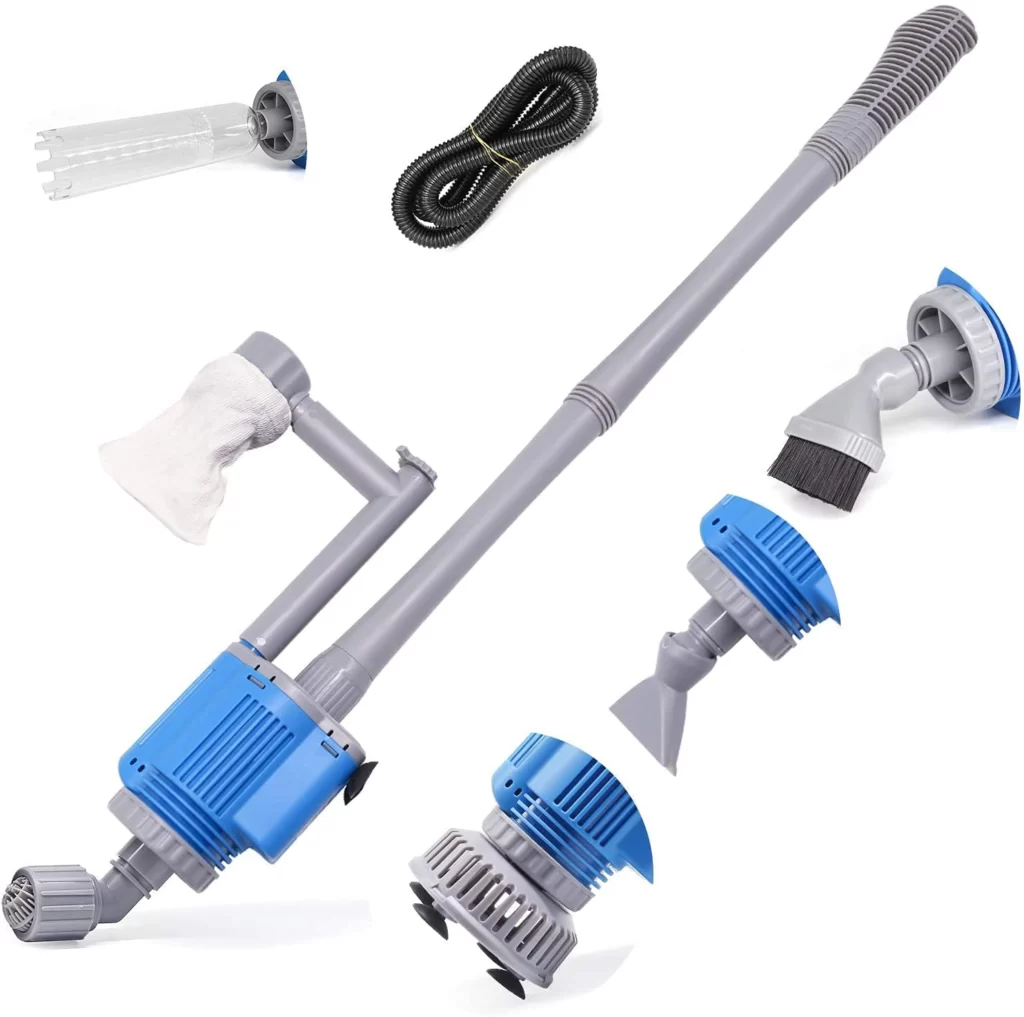
How to Clean Aquarium Sand without Vacuum
As an alternative to the gravel siphon, turkey busters may be used to block sand from getting into your vacuum kit if you don’t already have one. Even though it takes longer to obtain than a vacuum tool, a pressure kit (also known as a “tucker buster”) can precisely inject or properly remove substrate material. To clean aquarium sand without vacuum with the help tucker buster is very simple. The whole procedure consists of pointing, squeezing, and ejecting.
Cleaning Aquarium Rocks with Vinegar
Cleaning aquarium rocks with vinegar, fill a bucket halfway with water and vinegar at a ratio of one part tap water to one part vinegar. Place resin decorations, stones, and rocks in the bucket and fill the bucket halfway with vinegar. At least 5-10 minutes should be allowed for the decor to soak with in solution thoroughly. In this way, you clean aquarium rocks with vinegar.
How Do You Clean Aquarium Sand By Hand
To clean aquarium sand by hand, fill a clean barrel with sand, one packet at the moment, and hold the barrel up one side, so it is resting at an angle to prevent it from spilling. Fill the bucket halfway with water from a yard hose, and then use your hands to clean the sand, carefully swirling it about the bucket.
How to Clean Fine Aquarium Sand
How to clean fine aquarium sand, is a frequently asked topic among fish owners who are fresh to sand substrates. Moreover, the short and simple response is yes. If you have fine sand substrate in your fish tank, you should wash it off. The result will be regular water clarity problems, which may cause your filter to get clogged.
Is it hard to Clean Aquarium Sand
Many believe that since sand is so fine, it is more difficult to clean than gravel; however, cleaning it is similar to cleaning aquarium gravel. Indeed, it is often a more straightforward task to do.
How to Clean Black Aquarium Sand
If fine sand is not cleaned regularly, it may compress and become black. The bacteria that cause the black coloration and rotten smell are anaerobic bacteria taken home in unclean sand and produced the coloration. Anaerobic conditions are detrimental to the health of the fish and the aquarium as a whole.
To clean black aquarium sand, deep sand layers should be discouraged; often washed sand should be used instead for a healthy aquarium. To maintain the sand fresh and spotless, use a mix of substrate-dwelling fish and frequent gravel vacuuming.
How to Clean Aquarium Gravel without Removing Water
Investing in vacuum equipment is the most effective method to clean aquarium gravel without removing water. You always have the option of constructing one if you choose. For just a few simple items at your leisure. It takes just a few minutes for these vacuums to perform a complete cleaning, and you won’t have to worry about emptying anything.

